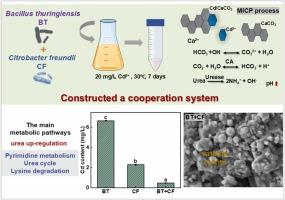A cooperation mechanism between Bacillus thuringiensis and Citrobacter freundii that enhances cadmium biomineralization
IF 11.3
1区 环境科学与生态学
Q1 ENGINEERING, ENVIRONMENTAL
引用次数: 0
Abstract
The viability and tolerance of individual ureolytic bacteria are a bottleneck in the remediation of cadmium (Cd) by microbially induced carbonate precipitation (MICP) technology. To solve this issue, strains of Bacillus thuringiensis (B. thuringiensis, BT) and Citrobacter freundii (C. freundii, CF) were isolated from soil and studied for their growth characteristics and metabolism. A cooperation system (BT+CF, 1:1, v/v) was constructed and exposed to 20 mg/kg Cd2+ for 7 days, compared with individual bacteria. The synergistic mechanism of strains that immobilize Cd2+ was explored using characterization techniques. Results showed that the main metabolic pathways leading to urea up-regulation were pyrimidine metabolism, urea cycle, and lysine degradation by metabolomic analysis. The cooperation system can effectively remove Cd2+ with an efficiency of 97.68%, which is higher than BT (66.66%) and CF (88.61%). The SEM-EDS, TEM, and XPS results revealed that the calcium carbonate polycrystals (vaterite and calcite) were formed during the MICP process, and the XRD and FTIR confirmed that the BT+CF produces more stable carbonate crystals. The BT+CF cooperation system was efficient at immobilizing Cd2+ by synergizing the molecular mechanisms of ureolytic bacteria. These results provide a novel perspective for the application of MICP.

苏云金芽孢杆菌与弗氏柠檬酸杆菌促进镉生物矿化的合作机制
微生物诱导碳酸盐沉淀(MICP)技术修复镉(Cd)的瓶颈是单个溶尿菌的生存能力和耐受性。为了解决这一问题,我们从土壤中分离到了苏云金芽孢杆菌(B. thuringiensis, BT)和弗伦地柠檬酸杆菌(C. freundii, CF)菌株,并对其生长特性和代谢进行了研究。构建BT+CF (1:1, v/v)的协同体系,并在20 mg/kg Cd2+环境下暴露7 d,与单个细菌进行比较。利用表征技术探讨了固定化Cd2+菌株的协同作用机制。代谢组学分析结果表明,导致尿素上调的主要代谢途径是嘧啶代谢、尿素循环和赖氨酸降解。该协同体系对Cd2+的去除效率为97.68%,高于BT(66.66%)和CF(88.61%)。SEM-EDS、TEM和XPS结果表明,MICP过程中形成了碳酸钙多晶(水晶石和方解石),XRD和FTIR证实BT+CF生成了更稳定的碳酸盐晶体。BT+CF协同体系通过协同溶尿菌的分子机制有效固定Cd2+。这些结果为MICP的应用提供了一个新的前景。
本文章由计算机程序翻译,如有差异,请以英文原文为准。
求助全文
约1分钟内获得全文
求助全文
来源期刊

Journal of Hazardous Materials
工程技术-工程:环境
CiteScore
25.40
自引率
5.90%
发文量
3059
审稿时长
58 days
期刊介绍:
The Journal of Hazardous Materials serves as a global platform for promoting cutting-edge research in the field of Environmental Science and Engineering. Our publication features a wide range of articles, including full-length research papers, review articles, and perspectives, with the aim of enhancing our understanding of the dangers and risks associated with various materials concerning public health and the environment. It is important to note that the term "environmental contaminants" refers specifically to substances that pose hazardous effects through contamination, while excluding those that do not have such impacts on the environment or human health. Moreover, we emphasize the distinction between wastes and hazardous materials in order to provide further clarity on the scope of the journal. We have a keen interest in exploring specific compounds and microbial agents that have adverse effects on the environment.
文献相关原料
公司名称
产品信息
索莱宝
carbonic anhydrase (CA) test kit
 求助内容:
求助内容: 应助结果提醒方式:
应助结果提醒方式:


